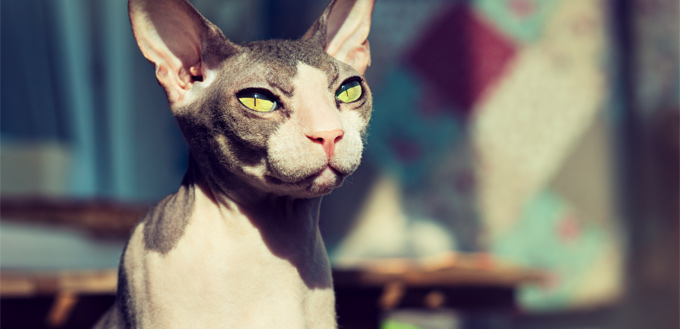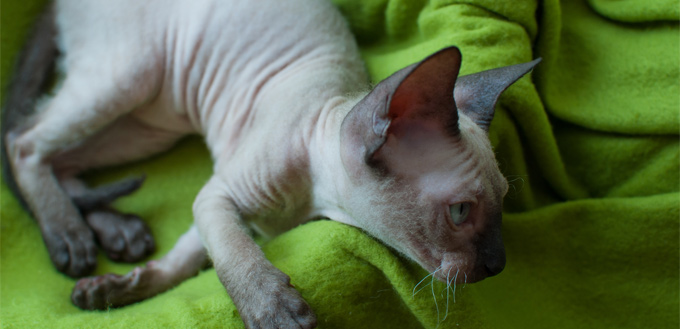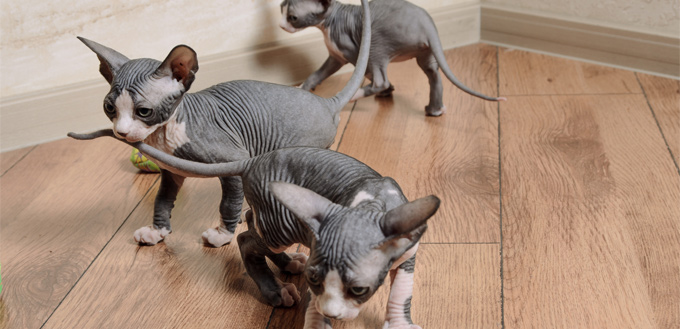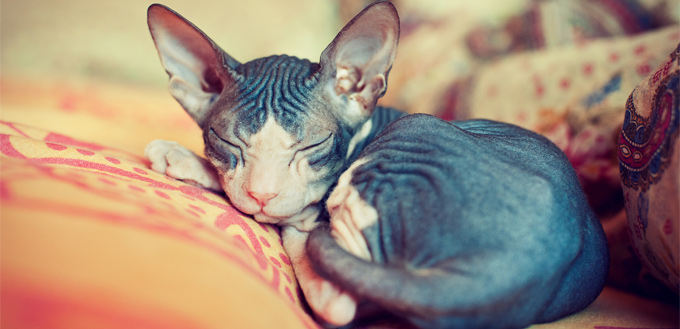The Sphynx cat is an immediately recognizably breed of feline owing to its total lack of fur coat. It developed like this through select breeding by cat breeders in the 20th century and is now one of the most famous types of cat around. Their skin is actually very soft to touch despite being without fur, but they are also known for their webbed feet and narrower than the usual head. They can still have the markings of a cat that has fur, so their skin can appear mottled or tabby-like depending on what line they have descended from. They can make great pets but one important thing to note is that they need to be in a warm house or live in a warm climate given that they have no way of maintaining a healthy body temperature otherwise.
To be deemed a member of the Sphynx breed, a cat needs to have the following characteristics to meet the necessary breed standards according to The International Cat Association or TICA:
- Distinct cheekbones set on a wedge-shaped head
- Big eyes in an almond shape
- Big ears with absolutely no hair inside though some soft down like hairs can be seen around the base.
- Muscular, lithe bodies with a particularly strong, longish neck.
- An average sized middle and torso characterized with a rotund or pot belly.
- A narrowing tail that is narrowest at the very tip. Some Sphynx will have a collection of fur or hair at the very end that looks almost like a cotton wool pad.
- Their paws are thicker set than with other breeds which makes their walk more pronounced than other cats.
In this Sphynx guide, we look at this and other characteristics to bear in mind if you are thinking about purchasing this breed of cat. It’s a good idea to read this thoroughly as, before taking any pet into your home, it is good to know all their traits – good and bad – to ensure whether they are the right cat for you or not. By making an informed decision, we can reduce the number of stray cats and the number of cats that end up in rescue homes and pounds.

History of the Sphynx Cat
So how did this curious breed of the cat come into being? Did they evolve naturally or were they bred to look their own distinct way? Well, the short answer is a bit of both, but the man definitely helped them propagate to the extent that they have.
It is thought that the Sphynx’s mass breeding was conducted in the 1960s in Europe using the rare cats that were hairless already. From there, after the discovery of a couple of other hairless cats in Canada and the USA, the line was extended and developed further. The North American hairless breeds are thought to have heavily influenced what has now become the existing shape of the Sphynx with its narrow head and webbed feet.
For this reason, the full name of the Sphynx that we know and love today is the Canadian Sphynx. Cat enthusiasts use this term to set it apart from other hairless breeds that are more commonly found in Russia.
In fact, it was by pure chance that it was a Canadian cat that influenced the Sphynx line so heavily. This is because it was a solely domestic cat that had a litter of cats that were hairless. Amongst the hairless cat litter from the domestic cat, was a male now known famously as Prune. He was then bred with his mother when he was mature enough to do so. This process of breeding is called crossbreeding and is fairly common amongst cat breeders – though novices may feel that the sound of it is far too incestuous.
The result of the crossbreeding with Prune and his mother was that they produced a litter with both hairless and furry coats. The hairless kittens were then exported to Europe and this is when European breeders went on to develop the line of the Canadian Sphynx cat. It is due to this mass breeding with other cats that a Sphynx can have so many different markings on his or her body. Any type is deemed as permissible to be included in the breed as long as it matches the other criteria stipulated by the TICA which are listed above.
It was in the late 80s that the first Sphynx was exhibited at a GCCF championship and the breed then went on to receive full recognition from the GCCF.
Quick Facts About the Sphynx Cat
- They’re not actually bald
The Sphynx cat is actually covered from head to paw in soft downy hair. It means that when we stroke them it often feels like we are stroking the softest leather. In fact, these soft hairs even cover their ears, noses, and tails. So for a cat that is known as hairless and furless, this is in fact totally incorrect!
- They’re not hypoallergenic
It is a common misconception that Sphynx cats are a great option for those that are allergic to cat hair. However, this is not the case. Whilst they are covered in very fine down hairs, it is actually what is in their saliva and skin secretions that have been known to cause allergic reactions in sufferers. So if you are after a cat but have a family member allergic to cats, it is best to look at another breed.
- They love to play fetch
Given their intelligence and energetic nature, they love playing games of fetch, much like a dog. Other dog-like characteristics include their love of being with people. They absolutely hate being left on their own for a long period of time and are far more social than any other cat breeds. Those that are not cat lovers as they think they are too independent should meet a Sphynx. They will completely change opinions on cats and their aloof natures.
- A pedigree cat can cost up to £800
There is no denying that this unique and distinct looking feline is not a cheap breed. In fact, a pedigree Sphynx has been known to cost up to £800. And these aren’t the only costs would-be owners should take into account. From the initial outlay and when taking into account their food needs and insurance, a Sphynx can cost around £40 to £60 to maintain a month. Obviously, this does not include the initial cost of the cat, their kitten vaccinations and any neutering that you deem necessary to undertake.
- They’re about four degrees warmer than most other cat breeds
Despite not having a coat, they are actually warmer than other cat breeds. It has been seen that some Sphynx cats are a whole four degrees warmer than their feline sisters. It is thought this has transpired to ensure that they stay a healthy temperature given their lack of fur coat. They still need to be kept warm when indoors at home however despite this naturally higher body temperature.
- They have fast metabolisms
Despite looking quite skinny, this is mainly due to the fact that they don’t have fur that creates a bigger silhouette in other cats. It is not because they do not eat very much. In fact, they have a very fast metabolism and so need more food than other cat breeds. This is something future owners should bear in mind before buying a Sphynx as their feeding needs can cost considerably more than other breeds.

Things You Should Know About the Sphynx
Before buying a Sphynx cat, it is good to know the low down on their health, feeding requirements, care & grooming and their temperament to ensure that you are making an informed decision. They can be absolutely wonderful pets, but that is not to say that they are suitable for all homes and households. Buying any cat needs to include a well-researched process so that there are no nasty surprises in store for anyone involved if you take a Sphynx cat back home with you – both for the cat but also for yourself.
Health
The Sphynx can live to a good age for a cat. It is thought that on average they live to about 13 to 15 years if they have been given the correct care and attention in terms of its dietary needs and health. While they are not a victim to many conditions that can affect other breeds, they have been known to be prone to Hypertrophic Cardiomyopathy which is when parts of the heart become too thick. This results in the heart not being able to circulate blood around the body as well as it should do. This can go on to cause lethargy, swelling in the legs and a shortness of breath. It may even cause your Sphynx to faint. Before buying your kitten, therefore, ask the breeder if this condition has been seen in the stud cat as the symptoms of it can then lead to other health issues.
It is also important for breeders to keep Sphynx kittens warm when very young. In doing so, breeders help protect against respiratory infections that can sometimes be aggravated by the lack of fur that the young cats have. When a kitten has had a safe and healthy environment to grow up in, and importantly have remained free of infections, they are much more likely to go on to live a long and healthy life.
Feeding
The Spyhnx is not known to be a fussy eater, but it is key to ensure they are kept on a nutritionally balanced diet to suit their needs. If anything, they are an expensive breed and therefore their food is the best way you can maintain your investment! A well-balanced diet will ensure that their digestive system works properly, that they receive the right amount of vitamins and minerals and that their skin and eyes remain healthy. They obviously, like all cats, need constant and free access to clean, fresh water at all times.
One key idea to keep note of is that when you first have a Sphynx cat in your home, it is best to keep your kitten on the same feeding schedule as the breeder did. This will help to maintain balance in its tummy and digestive system. If you introduce a different routine to their diet with different food, it can be too much for their young digestive systems to cope with so that they then suffer from an upset stomach. This is distressing for both them and you – especially when they are in a new place away from their mother and brothers & sisters.
If the schedule they kept is not suitable for you and your own routine, then start to change their diet as slowly and gradually as possible. If you are unsure, consult either your breeder or your vet who will be able to help you with the appropriate nutritional needs of your Sphynx and minimal stress and anxiety caused.
When your cat gets older, it is important to meet their nutritional needs with a top quality diet, which is fed to them several times a day. This helps balance the Sphynx’s fast metabolism. However, by feeding them several times a day it can mean that it can become easy to overfeed them. If you notice that your cat is putting on weight, start to decrease the amount you feed them little by little until their weight is at a healthy level again. Like all cats, an overweight Sphynx cat is far more prone to illnesses and conditions that can affect their quality of life due to the impact on their health and wellbeing. Keeping their weight at an optimal BMI is an easy way to help prevent conditions like arthritis or respiratory problems.
Related Post: Best Dry Cat Food

Care and Grooming
Despite having no fur, the Sphynx still needs to be groomed regularly. This includes a bath – weekly if possible. It means that their skin is kept in optimal condition and their coat remains healthy. They need a weekly bath as their skin still creates the same amount of oil that their fur-coated brothers and sisters do. This means that a bath will stop a build-up of a nasty greasy film on their skin. This is particularly important given the number of folds and wrinkles found on their bodies. If grease does build up in those places, your cat could be prone to sores and infections developing which are not only painful but can also require veterinary help to clear up. It should not be an onerous task to bathe your cat however as the Sphynx loves a warm bath and spending quality time with its owners.
At the same time, owners should pay attention to any dirt build up in their ears. Their ears are far more prone to getting blocked as they have no hair to stop dead skin cells or the like building up in the ear cavities.
Related Post: Best Cat Ear Cleaner
Their skin has also been known to be sensitive. While this does not mean that you have to slather on sunscreen when the sun is out and burning brightly, it does mean that they can, indeed, get sunburnt. In the main, to overcome this and the fact that they can conversely (though understandably) get cold very easily, they should really be seen as indoor cats for the most part. If you like cats to go outside, then perhaps this is not the breed for you.
In all these cases, prevention is the best way to cure this cat breed of their predisposition to skin sores and ear infections. So wash them regularly and keep them indoors.
Temperament
The Sphynx has plenty of distinctive features to its character and temperament. For an intelligent cat, they are actually fairly stuck in ways and hate change. This means they like to be fed to schedule every day and will also dislike it if their owners move furniture around in their homes. In fact, changes like these have been known to cause anxiety in this breed so it is best to keep their routines as strict as possible to avoid any stress affected them.
However, if you bring a Sphynx into your home, you are inviting one of the most affectionate breeds of cat into your home that is possible. It is thought it is down to their intelligence and smart ways that they are able to form a bond with their owners of such a strength that is usually not seen in cats. For this reason, Sphynx owners need to bear in mind that these cats are ideally suited to a home where there is someone at home for most of the day. They hate to be left alone.
When an owner is a home, however, it is extremely common to see a Sphynx try to hold a conversation with their best friend. They are known to be exceptionally talkative. As an extension of conversing with their owner, they also love to be petted and love cosying up to a loved one for a cuddle. This makes them fantastic family pets and a very popular member of the family.
They have playful natures and so enjoy any type of interactive toys and games that involve a great deal of attention from their owners. When not playing or snuggling up to a family member, they will be found exploring their wider environment or simply following their owner round – much more like a lovesick puppy. This can make them quite high maintenance in some respects as they are certainly not known for their napping ways, but their loving nature means that they tend to fit in with a family of all shapes and sizes easily. This makes them great additions to households with dogs amongst other animals. In fact, many Sphynx owners advocate having other animals in the home to keep a Sphynx happy. They love the company. They are often also known to be outgoing – perhaps one of the reasons why they love being part of a busy household.
Other Notable Characteristics of the Sphynx
The Sphynx is known for its energetic nature. It is exceptionally playful and they do not nap nearly as much as many other cat breeds do. Given that they are mainly kept indoors due to their sensitive skins, this means that owners have to find ways to keep their cat entertained so that they do not wreak havoc on their homes through boredom. A Sphynx cat absolutely loves to be up high, so owners often try to create cat highways in their homes so that their cats can wander around a room from a high vantage point that they enjoy having.
When a Sphynx does like to nap, it is in a warm place – preferably next to their owners. If you are out intermittently throughout the day, think about leaving out heated cat pads that will keep your Sphynx nice and toasty when you are out.
They are an intelligent breed that can learn new tasks quickly. They are also extremely affectionate and so are a good option for homes with children. That being said, cats should never be left alone with the very young, despite how caring a Sphynx can be. And while their temperaments also lend themselves well to homes with dogs as well as other cats, care should be taken in the initial few stages of introduction, however.

Bottom Line
The Sphynx can make a great household pet – while it is not without its own individual needs, their loving and caring ways means that they are often one of the best-loved members of any family.
Sources:
- John Perritano, Sphynx Cats Are Surprisingly Sweet and Cuddly, HowStuffWorks
- Dr. Katie Grzyb, DVM, What You Need to Know Before Bringing Home a Sphynx Cat, PetMD






